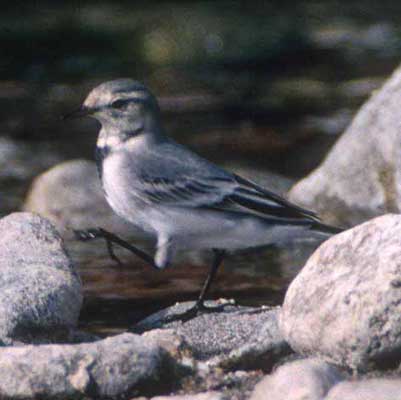
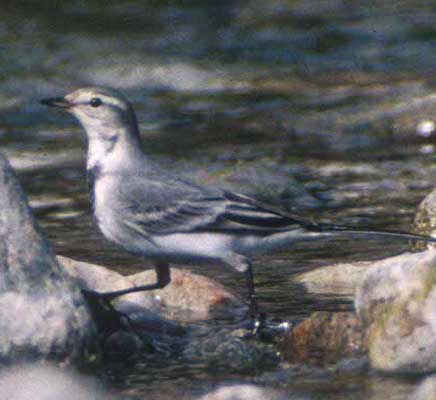
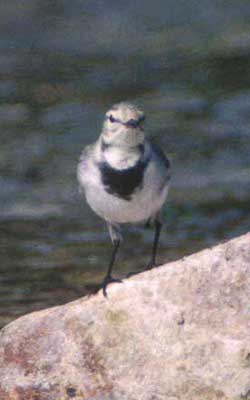
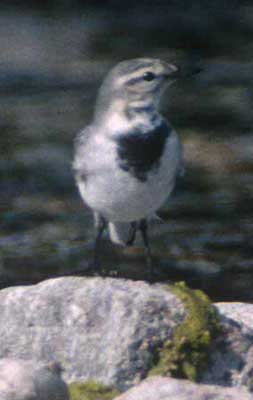
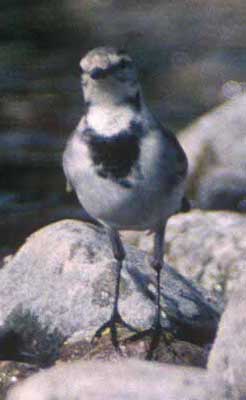

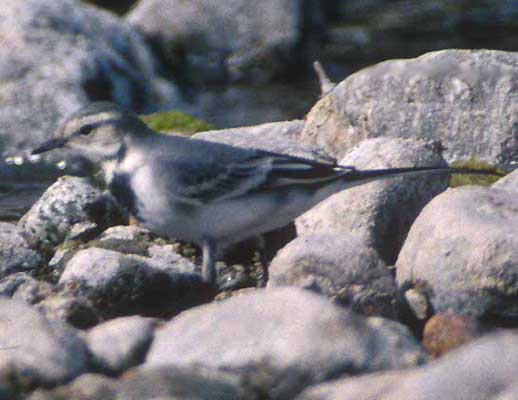
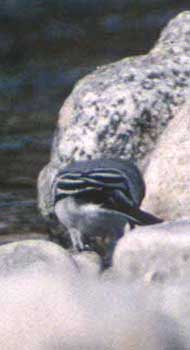
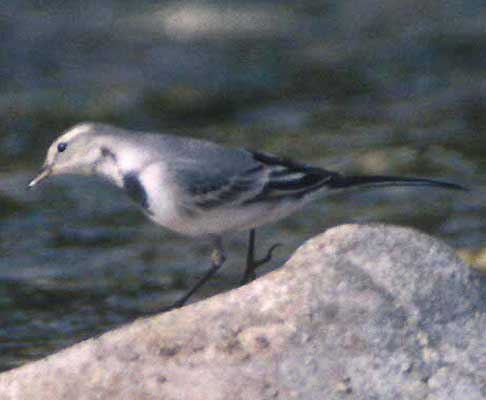
The following details, along with copies of original field notes, were submitted to CBRC:

photos and introduction by Don Roberson
On 29 Sep 1998, Todd Easterla found this wagtail along the Big Sur River
near the river mouth. He alerted various local birders (including me) and
I identified it in the field as a White Wagtail Motacilla alba showing
characters of the race ocularis. I submitted a series of photos
and my notes to the California Bird Records Committee (CBRC) under that
name. The CBRC, however, rejected the report as a White Wagtail; it was
considered a Black-backed Wagtail M. lugens by several reviewers.
These photographs document the occurrence; my field notes and initial discussion
is appended followed by selected comments of CBRC members during review
and by a guest commentator selected by CBRC (these were obtained through
the courtesy of Mike Rogers from the public files of CBRC at Western Foundation
of Vertebrate Zoology). The analysis is contradictory in various respects
and it seems clear to me that several reviewers misinterpreted or failed
to read my written details (see footnotes at the end). In any event there
is much information here for you to form your own opinion about the identification
of this interesting wagtail.









The following details, along with copies of original field notes, were
submitted to CBRC:
WHITE WAGTAIL
Motacilla alba ocularis
28 Sep 1998 at the Big Sur River mouth,
Monterey County, California
This wagtail was discovered by Todd Easterla. It was initially identified as a Black-backed Wagtail M. lugens. That was what I was told it was when I arrived. However, my observations led me to believe it was a White Wagtail of the Siberian race ocularis. Much of my thinking is expressed in my field notes (attached). [The attached hand-written notes, written the day of observation and before any photos were developed (but anticipating that there will be photos developed) include these thoughts: "See photos for more, but I aged it as an adult because 1) primaries & tertials crisp black and apparently unworn, 2) no brownish feathers in plumage, 3) face pattern crisply gray & white with all-white auriculars, 4) white supercilium edged above and below (=eyeline) with charcoal-gray, and 5) charcoal patch on flanks. Judged a White Wagtail because 1) remiges dark (in flight), 2) greater coverts with white panel with numerous gray 'teeth' at base of feathers (=inner webs basally), 3) crown gray and back uniform gray without any hint of black, 4) forecrown white with a buffy wash (I believe adults can show this buffy case to forecrown), 5) bill looks smallish to me (it is dark with pale base to lower mandible), 6) the upper rump is same gray (actually a bluish-gray) as back but changes to charcoal uppertail coverts at lower rump, 7) median coverts black-centered but have white tips, forming upper wingbar above which a black line of 'droplets' formed by black centers to median coverts, [and] 8) lesser coverts uniform gray, as far as I can tell. Underparts all white except for black crescent across chest & smudge to side of neck (see photos); tail long with black central rects & white outers (details not determined -- it was always wagging its tail). Legs black. Always called in flight -- a loud 'chiz-zick!' which I could hear from as far away as Cooper cabin [=several hundred yards]."
In the field, I felt the identification could only be made if the bird
could be aged, so I focused on those points that I recalled from Joe Morlan’s
classic article in Continental Birdlife (1981) [Vol. 2, No. 2].
I determined that the remiges were jet black, crisp, and unworn. My recollection
was that this aged the bird as an adult in fall. The ageing of the bird
as an adult seemed further confirmed by a white forehead, by distinct charcoal
lines above & below the supercilium, and by a gray patch on the flanks.
If the bird was an adult, the greater wing-covert pattern could only belong
to a White Wagtail. Further, no white was apparent on the remiges in flight.
The bill also looked smallish to me, consistent with this tentative i.d.
After returning home and after writing my field notes, I consulted
Sibley & Howell’s (1998) “Identification of White and Black-backed
Wagtails in basic plumage” [Western Birds 29: 180-198], a paper
I had not previously read. About that time Todd Easterla & Jim Booker
showed up at my house, and we looked at it together. We all agreed that
the bird was closest to one of the middle two wagtails illustrated in the
right-hand column of Figure 7; these are labeled adult female or imm. male
“Swinhoe’s White Wagtail.” Most obviously, the bird had black-centered
median coverts that formed a very prominent line of black “droplets” above
the upper wingbar. We judged the greater covert pattern to be more like
that shown for the “immature male” but the face pattern more like the “adult
female.”
The paper gives ageing criteria that was contradictory on this bird. The front of the face was washed with pale buffy-yellow (no brown), consistent with either age (p. 189 of their paper), but the forehead was cleanly white and distinctive from the gray crown. This is a feature of adults in fall & early winter (see p. 183). Yet, the bird had an obviously fleshy-pale base to the lower mandible. This is a feature of young birds according to Table 4 (p. 196), although they acknowledge more study is needed as bill color may change.
In reviewing my photos, I see no “molt limits” to the greater coverts (nor did I in the field) which suggests an adult. Yet the overall upperwing-covert pattern shown recalls the concept of two white wingbars, a feature better for first-year birds. The rump/uppertail coverts dividing line is okay for an adult female White or for immature males of either species. The bluish tone to the gray back suggests an adult. The very clean gray crown may be better for immatures. Ageing is ambiguous using the Sibley/Howell paper, while it seemed clear-cut with Morlan’s paper.
The dark bases to the secondaries (apparent in the photos), which recall a Ruby-crowned Kinglet pattern, is consistent with ocularis White Wagtail, as is the median covert pattern. Thus, although ageing may be more problematic than originally thought, the bird still appears to be an ocularis White Wagtail.
--
these details & photos provided by Don Roberson
CBRC REVIEW (record #1998-173):
In the quotes of comments below, words in parenthesis are those
of the commentator while those in brackets [] are additions added for clarity.
COMMENTS of PETER PYLE in CBRC review:
1st round (votes reject): "I concentrated on ageing this bird by the
photos and am not all convinced that it is an adult. The moderate amount
of wear evident on the coverts and contour feathers is consistent with
HY. Adults of European wagtails molt on the summer grounds and appear extremely
fresh in the fall. This bird doesn't appear fresh enough. If ocularis happens
to be different and molt on the winter grounds then, by contrast, it would
appear much more worn than the bird in the photos. Crisp, unworn, black
remiges could describe those of either age group in the fall. I cannot
tell if there is a molt limit between the median coverts and greater coverts
visible in the best shot. It is also possible that ocularis may not molt
as many coverts as European forms and that they are all still juvenal (although
the medians don't look juvenal to me). I'm not sure about the face and
bill criteria but suspect that this could go either way as well... As to
what species assuming the age is unknown: it's hard to say. In general
I agree that the median covert pattern (assuming basic rather than juvenal
feathers) looks better for White than Black-backed. The lack of black in
the upperparts may also point ot White, but the charcoal uppertail coverts
(along with the pure gray back) can be found in HY female Black-backeds.
Thus, although I favor White Wagtail (female or HY male) I don't think
HY female Black-backed can be ruled out."
2nd round (votes reject): "... I am [now] convinced this is an HY bird. The plumage and wing coverts are just too worn for an adult. The median and greater coverts lack the fresh and smooth look that adults shows. Interestingly, I now think (contra my earlier comments) that the outer four median coverts (at least) have been retained (it's possible that the fifth one has been replaced but I can't be sure). Thus were are looking at juvenal median coverts, which are similar on both species. While I agree with Steve [Howell] that both ages MAY lack molt limits, especially as viewed in the field, I believe that difference in the quality and wear of the coverts, with experience, can still be sued to age them. This bird is clearly HY based on this. Assuming HY I would say it is either a female Black-backed or a male White.... My hunch is that this is an HY female Black-backed, as Guy [McCaskie], Steve [Howell], and Michael [Patten] concluded. Trying my best to be objective, I'm just not quite ready to eliminate HY male White yet."
COMMENTS of JOE MORLAN
1st round (votes accept): "I agree it is a White Wagtail, but I think
it is an immature and probably a female at that... The face pattern shows
retained juvenile ear-coverts which are found only on immatures. The wing
pattern is diagnostic of immature White Wagtail... The yellow on the face
is useless as a aging character and is found occasionally on both species
so it is also useless as an identification character."
2nd round (now votes reject): "I am convinced this is an immature HY. The dusky ear coverts are retained juvenal feathers. As such, the extensive white fringing to the greater coverts and lack of black bases to the median coverts should identify this as a Black-backed Wagtail, probably female and I will endorse it as such. I also think the legs look thick and sturdy, good for Black-backed."
COMMENTS of GUY McCASKIE
1st round (votes reject): "... The fact that this wagtail had a mostly
all black rump/uppertail-coverts leads me to believe it was a first-fall
Black-backed Wagtail rather than a White Wagtail." [see footnote 1]
COMMENTS of MICHAEL A. PATTEN
1st round (votes reject): "Based on the pale base to the mandible and
the coloration on the face and crown, I believe that this bird was an immature....
First-year female White Wagtails should have far less white in the wing
coverts, and I would not expect the 'tertial' fringes to be so bold (essentially
equally thick along their length) on either sex of a White Wagtail."
COMMENTS of ALVARO JARAMILLO
1st round (votes accept without further comment).
2nd round (now votes reject): "The photos and description had me convinced that it was a White. Steve Howell's letter [see below] casts doubt on this ID, so I am changing my votes based on a more experienced person's analysis. However, by looking at the photos and the paper [by Sibley & Howell] this bird would be identified as a White based on my interpretation."
COMMENTS of ROBB HAMILTON
1st round (votes accept without further comment).
2nd round (now votes reject): "Thanks to .. Steve Howell for providing an outside review. I went along with Don Roberson's testimony that the very obvious bases of the median coverts were black (not charcoal gray), and appear to have relied too much on earlier commentary from David Sibley (attached to ... the Moonglow Dairy bird [record]) that 'The barely visible dark bases of median coverts are characteristic of White Wagtail, and virtually eliminate Black-backed.'... Howell's review of this record, and recent discussions with him, suggest apparent disagreement between him and Sibley regarding the expected range of variability in the median and greater coverts of these two 'species'."
COMMENTS of STEVE N. G. HOWELL [obtained at CBRC request]:
"This is an interesting record. I am (not) amazed at how the observer's
reality differs from that which his photos show, and instead I offer the
following evaluation which, painful as it may be, differs from the observer's
analysis. While I agree that the photos most closely resemble one of the
middle two right-hand figures in Figure 7 of Sibley and Howell, as is often
the case, reading (and understanding) the text of an identification article
may be more important than scanning through, seeing what one wants to see,
overlooking other information, and looking primarily at the pictures. I
also wish David had painted the immature female Black-backed differently,
as many look much closer to White in overall appearance....
Don [Roberson] writes in his description 'the forehead was cleanly white' and 'most obviously, the bird had black-centered median coverts that formed a very prominent line of black 'droplets' above the upper wingbar.' [footnote 2]
Perhaps he photographed the wrong bird? At least to my eyes, the forehead looks dirty buffy with some dusky mottling ... and while the median coverts have dark centers they sure don't look black (except when shadowed) and instead look charcoal-grey which is fine (perfect, even) for immature female Black-backed Wagtail (e.g., see figure 3b of Sibley and Howell, and also similar to figure 3c) and differs from the black or blackish center of White Wagtail.
The photos do not show the remiges satisfactorily, but I would like to think Don knows that all ages have fresh remiges in fall and that wear-related differences causing browner immature remiges generally don't kick in till late winter and are most pronounced in summer. Given how he (mis)interpreted forehead color and median-covert pattern, however, I am not confident his 'jet black' is how other see jet black.
Age is problematic. Not all HY wagtails molt coverts (especially females?)
so uniform coverts does not help in ageing (only the presence of molt limits
is good for HY in fall, the absence is not diagnostic of age). Bill color
is a tentative mark but, combined with dirty buffy forehead and generally
dirty face, seem reasonable for HY. 'Small' bill is fine for female Black-backed.
So, I consider this bird to be a HY female Black-backed Wagtail.... While
I can't be 100% sure of the identification (who can), I'd accept this as
... a bird showing characters of Black-backed Wagtail -- going out on a
limb, huh? Now, Don will go out of his way [to] find a saw to cut the limb.
Joy, oh joy."
CBRC REVIEW RESULT:
On the second round, this was rejected as White Wagtail by a 0-10 vote.
Four members (McCaskie, Morlan, Patten, Rogers) would have accepted as
Black-backed; remainder would accept only as "White/Black-backed." The
CBRC thereafter eliminated the acceptance category of "White/Black-backed
Wagtail" and thus from the CBRC's standpoint it stands in the same position
(rejected) as those claims of wagtails which seem likely to be albinistic
blackbirds or something other than a wagtail (e.g., Heindel & Garrett,
16th CBRC report, Western Birds 26:24).
Footnotes by Roberson:
1. The bird did not have an mostly all-black rump as suggested by McCaskie. My notes said "the upper rump is same gray (actually a bluish-gray) as back but changes to charcoal uppertail coverts at lower rump." I believe you can see this on a couple of the photos.UPDATED INFORMATION:
2. Howell quotes my description of the forehead out of context. My field notes clearly state "forecrown white with a buffy wash." The later reference that "forehead was cleanly white" was referring to figure 2 in Sibley & Howell's paper (at p. 184) which showed three types of forehead patterns: "(a) forehead white..., (b) forehead mottled or flecked dusky ..., (c) forehead dusky...". Among those categories the forehead looked white in the field, and much closer to Sibley/Howell's figure 2a than 2b or 2c. There is no dispute it was also washed with buffy-yellow.
In Feb 2001 I posted a note on this age on the Oriental Birds chat line (orientalbirding@egroups.com) and asked experienced observers in Asia to comment on the identification, including such unresolved questions as: "(a) do only first-year birds have a pale base to mandible, (b) do only first-year birds show a dingy yellowish wash to the forehead, (c) are the ear-coverts shown on this bird characteristic of first-year birds only? And, (d) if so, how is the wing-covert pattern explained?"
Among those who responded was Per Alström, author of the soon-to-be-published major book on wagtails and pipits. He wrote (posted here with his permission) the following:
"Dear Don,
Krister Mild and I both had a look at your photos. The bird is
a first-winter ocularis (100% certain). Sexing is not possible.
Birds with extensively dark centres to the median and greater coverts can
always be identified as ocularis (which usually retains all of its
juvenile secondary coverts in the autumn, unlike lugens which usually
moults most or all; the rare lugens with retained juvenile med +
gr covs show less extensive dark centres than your bird, especially the
meds, which show only dark shaft-streaks in the field). However, birds
with all white meds + gr covs are are not identifiable to taxon using that
character. [As to your questions]:
Per Alström
Department of Systematic Zoology
Evolutionary Biology Centre
Uppsala University, Sweden
e-mail: per.alstrom@ebc.uu.se